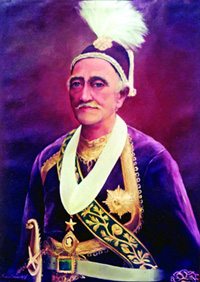
Sonargaon is a historic city in central Bangladesh. It corresponds to the Sonargaon Upazila of Narayanganj District in Dhaka Division.

Dhaka (Dacca) is a modern megacity with origins dating from 500 BC to 200 BC. The history of Dhaka region begins with the existence of urbanised settlements that were ruled by Gangaridai, Gupta Empire, Gauda Kingdom and Buddhist or Shaivite Pala Empire before passing to the control of the Hindu Sena dynasty in the 10th century CE. After the reign of Sena dynasty, the region was ruled by the Hindu Deva dynasty.

Shahbagh is a major neighbourhood and a police precinct or thana in Dhaka, the capital and largest city of Bangladesh. It is also a major public transport hub. It is a junction between two contrasting sections of the city—Old Dhaka and New Dhaka—which lie, respectively, to its south and north. Developed in the 17th century during Mughal rule in Bengal, when Old Dhaka was the provincial capital and a centre of the flourishing muslin industry, it came to neglect and decay in early 19th century. In the mid-19th century, the Shahbagh area was developed as New Dhaka became a provincial centre of the British Raj, ending a century of decline brought on by the passing of Mughal rule.

Nawab Bahadur Sir Khwaja Abdul Ghani was the second Nawab of Dhaka and the first to assume the title of Nawab as hereditary, recognized by the British Raj.

Khwaja Alimullah was the first Nawab of Dhaka. He was the founder of the Dhaka Nawab family.

Nawab Khwaja Habibullah Bahadur was a politician from East Bengal, soldier, social worker, and the fifth Nawab of Dhaka. He was the son of Nawab Sir Khwaja Salimullah Bahadur. Under Habibullah's rule, the Dhaka Nawab Estate went into decline until its actual relinquishment in 1952 by the East Pakistan Estates Acquisition Act.

The Nawab of Dhaka, originally spelt in English Nawab of Dacca, was the title of the head of one of the largest Muslim zamindar in British Bengal and Assam, based in present-day Dhaka, Bangladesh. The title of nawab, similar to the British peerage, was conferred upon the head of the family by Queen Victoria as a recognition of the first Nawab's loyalty and contribution to the social welfare activities.

</ref>

Ibrahim Shah Sultan Balkhi, also known by his sobriquet, Mahisawar, was a 16th-century Muslim saint. He is associated with the spread of Islam in Sandwip and Bogra.

The Bengal Armenians were ethnic Armenians who lived in what is now called Bangladesh. Their numbers have gradually diminished and there are now no Armenians in the country.

Nuruddin Sikandar Shah was the Sultan of Bengal in 1481 CE for a brief number of days.
Ruknuddīn Bārbak Shāh was the son and successor of Sultan Nasiruddin Mahmud Shah. Initially appointed as the governor of Satgaon during the reign of his father, Barbak ascended the throne of the Bengal Sultanate in 1459. He was the first ruler to give prominent roles in the Sultanate's administration to the Abyssinian community. Historian Aniruddha Ray credits Barbak Shah as the pioneer of urbanisation in Bengal.

Shahbaz Khan Mosque is a historic mosque located in Dhaka, Bangladesh. Located near Mir Jumla’s Gate, this mosque serves as an example of late Mughal architecture in Bengal, known as the Shaista Khan architectural style.

The Dhanmondi Shahi Eidgah, also known as Mughal Eidgah, is located in Saat Masjid road, in Dhanmondi residential area of Dhaka, Bangladesh. The Eidgah was built in 1640 CE during the Mughal era and has been in use for Eid celebration since then.
Nawab Bahadur was a title of honour bestowed during Mughal Empire and later during British Raj to Indian Muslim individuals for faithful service or acts of public welfare.

Nawabpur Road is a road in Old Dhaka City, Bangladesh, and is associated with the Shankhari and Gulistan bazaars. It is a busy road often jammed with rickshaws, human drawn carts, and foot traffic.
Shah Niamatullah Butshikan was a wali of the pre-Mughal Empire period. He preached Islam in the Indian subcontinent. His grave is situated in Dilkusha, Dhaka.
Bayazid of Sylhet, also called Bayazid Karrani II, was a ruler in Sylhet during the early 17th century, in what is present-day Bangladesh. A prominent member of the Baro-Bhuiyan, Bayazid led military opposition against the Mughal Empire's expansion into eastern Bengal. His surrender following a sanguineous battle in 1612 ultimately resulted in their annexation of Sylhet.
Karāmat ʿAlī Jaunpūrī, born as Muḥammad ʿAlī Jaunpūrī, was a nineteenth-century Indian Muslim social reformer and founder of the Taiyuni movement. He played a major role in propagating to the masses of Bengal and Assam via public sermons, and has written over forty books. Syed Ameer Ali is among one of his notable students.

Shāh Nūrī Bengālī was an 18th-century Bengali Islamic scholar and author from Dhaka. He is best known for his magnum opus, Kibrīt-e-Aḥmar, which was written in the Persian language.

















